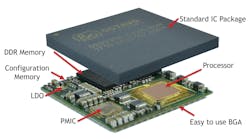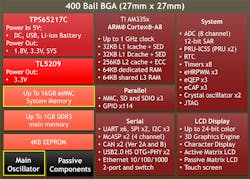Over 100 components are packed into Octavo Systems’ complete system-in-package (C-SiP), a feat that would otherwise require them being designed into a custom circuit board. Replete with timing and power management, the OSD335x C-SiP only needs power and any peripheral sensors or controls that will be utilized by the module (see figure). The pinout for the C-SiP is designed to makes it very simple for designers to create carrier boards that are significantly easier to implement, including two- to four-layer boards.
The boards can often be half the size versus a non-SiP design. On the plus side, there’s no need for complex DDR layouts or implementing proper power sequencing. All of these are handled by the C-SiP. The SiP also incorporates most of the devices that would have issues with EMI, so there’s none to speak of.
The OSD335x C-SiP is based on TI’s AM335x SoC with a 1-GHz ARM Cortex-A8.
The system is based on Texas Instruments’ AM335x system-on-chip (SoC). This includes a 1-GHz ARM Cortex-A8 processor. The module also features 16 MB of eMMC flash memory, while main memory consists of 1 GB of DDR3. On top of that, there’s a 4-kB EEPROM. A TPS65217C PMIC handles power management, and the system uses a TL5209 that provides a 3.3-V output.
The system also includes all passives and the system oscillator. No off-chip components are required other than a power source. The C-SiP approach means developers have fewer parts to maintain. These would include any additional interfaces or peripherals needed for an application.
The C-SiP provides a wide range of interfaces, including a graphic system that supports 24-bit data and has a 3D graphics engine. It can handle active and passive LCD displays with or without touch interfaces. The analog side has an 8-channel, 12-bit SAR ADC. The AM335x maintains two programmable real-time unit industrial communication subsystems (PRU-ICSS). These can provide features like real-time network support.
Digital timing support includes enhanced PWMs and multiple timers. The enhanced quadrature encoders (eQEPs) and enhanced capture (eCAP) modules provide advanced motor and servo controls.
There are a range of serial interfaces, such as dual CAN 2.0 interfaces and a Gigabit Ethernet port with a two-port Ethernet switch.
The systems are available in commercial and industrial temperature versions. The C-SiP comes in a 27- by 27-mm, 400-ball module.



